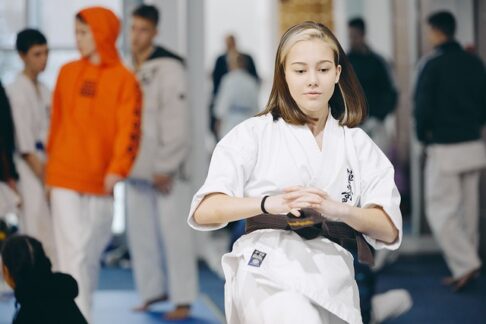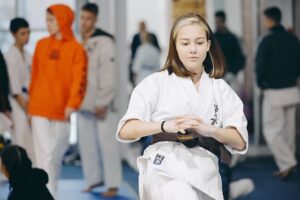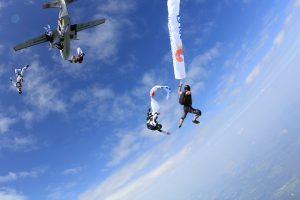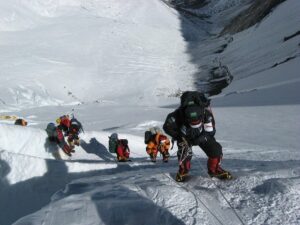Visualization in technical sports: internal or external?


Last modified: 21-09-2021
Visualization is one of the mental techniques helpful in acquiring new motor skills. It can be from the perspective of oneself (internal visualization) or from the perspective of an external observer (external visualization). Which one is more effective?
Hardy and Callow tried to answer the question by conducting research among people practicing sports in which technique is important: karate, gymnastics or climbing.
Visualization in karate
The study participants were 25 karate practitioners, ranging from 4 kyu to 1 dan. Their task was to learn a new layout, consisting of 52 movements (Jion kata). 4 people were excluded due to poor visualization skills, which was examined with a questionnaire before training, and the rest were divided into three groups: one group was asked to imagine before each exercise how they perform appropriate movements from their perspective (internal visualization), the other the group was to visualize themselves from the perspective of another person (external visualization) and the third group, the control group, performed gentle stretching before each exercise.
The training results of the new kata were checked after 2 weeks and after another 3 weeks. Then, after another 2 weeks, during which the participants did not train Jion kata anymore, it was checked to what extent the acquired skills were retained.
It turned out that after 2 weeks of training, the differences between the groups were not yet visible, but after another 3 weeks, people using external visualization had better results than those, who did internal visualization, and both groups did better than the control group. People who used visualization techniques also retained the acquired skills to a greater extent, and here, too, people who used external visualization presented a better level.
Visualization in gymnastics
The study involved 76 fairly beginner gymnasts, students of physical education faculties. Of these, 40 were selected who did well on the visualization skills questionnaire and who were to learn a new gymnastic sequence.
In addition to internal and external visualization, the study also tested the effectiveness of kinesthetic visualization (the imagery of what they will feel when performing a sequence of movements). The participants were divided into 4 groups: external and kinesthetic visualization, internal and kinesthetic visualization, only external visualization, only internal visualization.
The results showed that the new skills were acquired to a better extent by people who used external visualization than internal visualization. After 4 weeks, when it was checked to what extent the skills were retained, no statistically significant differences between the groups were found. Kinesthetic visualization proved ineffective in acquiring and maintaining new skills, but interestingly, people who used this technique gained more confidence that they could perform the new sequence well and felt that the visualization technique they were using was appropriate for them. The authors of the study suggest that this may be because study participants have little experience in gymnastics. As we know from previous studies, in the early stages of learning, athletes rely more on verbal and visual cues, and only in the later stages of advancement do they rely on sensory cues. Perhaps the study participants were aware that kinesthetic visualization could improve their results, but were unable to apply this technique at their stage.
Visualization in climbing
The third study was similar to the previous one, but the participants were climbers of a higher level than gymnasts. The study involved 10 people climbing at the 6b / 6c level and the same number at the 5c / 6a level. It took place on a bouldering climbing gym, where participants had four boulder problems to solve, selected with difficulty so that they would not be able to do it in the first attempt.
Again, it turned out that external visualization gives better results than internal visualization, what is more, kinesthetic visualization was also effective.
Is only external vizualization effective?
While research has shown that external visualization produces better results than internal visualization, it does not mean that this will be the case in all situations. Whiting and den Brinker distinguish between “the image of the act” and “the image of achievement”. “The image of the act” is a general imagery of what you want the movements to look like, while “the image of achievement” refers to more precise aspects like which muscles and with what force to use to make the movement.
The authors of the study suggest that external visualization may be more effective in the first stages of learning a new sequence of movements, which was experienced by the participants of their research. In the later stages, when we remember the sequence of movements and want to improve it, internal visualization can bring better results. I do not know if anyone checked whether their assumptions are consistent with reality, because I could not find such a publication, but it makes sense to me ;)
References
Hardy L., Callow N. (1999). Efficacy of External and Internal Visual Imagery Perspectives for the Enhancement of Performance on Tasks in Which Form Is Important. Journal of Sport & Exercise Psychology, 21, 95-112. (pdf at researchgate.net)
Author: Maja Kochanowska






Add comment